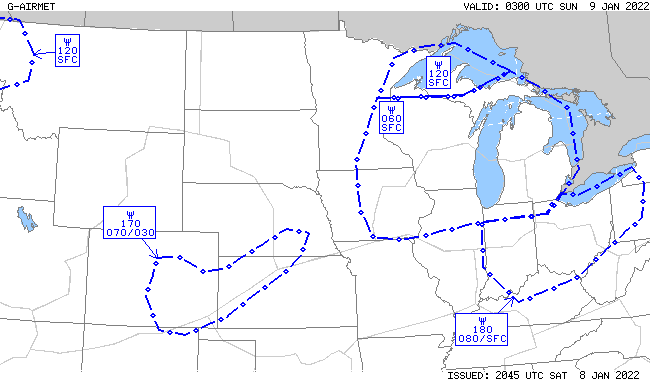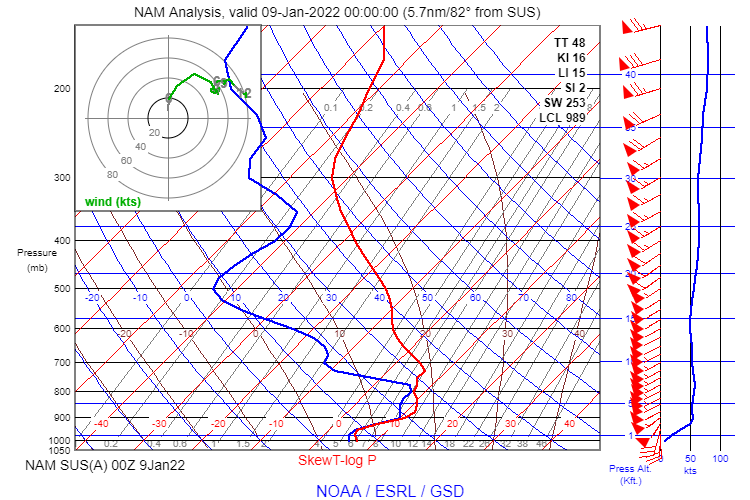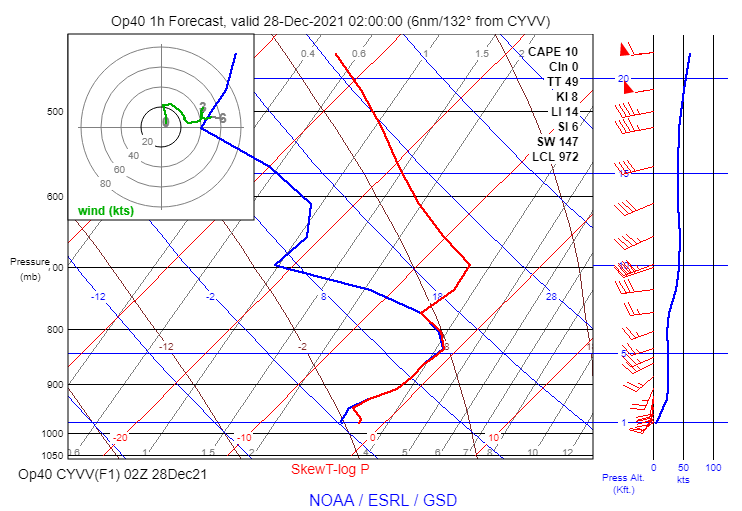-
Posts
456 -
Joined
-
Last visited
-
Days Won
3
Content Type
Profiles
Forums
Blogs
Gallery
Downloads
Media Demo
Events
Everything posted by Scott Dennstaedt, PhD
-

Weather chart quiz
Scott Dennstaedt, PhD replied to Scott Dennstaedt, PhD's topic in Miscellaneous Aviation Talk
Ah yes...and the reason for the question. You fell into my trap Dan. -

Weather chart quiz
Scott Dennstaedt, PhD replied to Scott Dennstaedt, PhD's topic in Miscellaneous Aviation Talk
Yes, that is correct. But there is a reason for this. I discuss that in one of my YouTube videos that discusses these progs charts. You can view it here. I apologize for the audio...my other microphone I normally use was TU when I made this video. Having said that, this is just an administrative aspect of how this chart is created, but does not drive the answer to the original question on how this area in northwestern GA should be interpreted. -
On the short range prog chart below, what does the dark green color depicted over northwestern Georgia imply? A - A forecast for the likelihood of moderate to heavy non-convective rain over a six hour period ending at the valid time on the chart B - A forecast for a 55% or greater likelihood of non-convective rain reaching the surface at the valid time on the chart C - A forecast for non-convective heavy rain over a 12 hour period beginning at the valid time on the chart D - None of the above
-
Just to be clear, this particular radiosonde observation showed that the static air temperature at ~8,000 feet was +2°C. And then cooling to 0°C at ~9,000 feet. This observation was approximately 100 nm northeast of the accident site. Near the accident site, the temperatures were warmer such that the freezing level was nearly 12,000 feet. So any aircraft taking off and climbing in this environment would have not accreted or expect to accrete any airframe ice. Eventually as the flight headed west toward Denver, the freezing level was trending lower and would have been below freezing upon reaching the KC area...even so, the amount of moisture at 8,000 feet was negligible in the KC region. It's not until the last third of of the flight where icing conditions would have been problematic as can be seen by this G-AIRMET valid at 03Z.
-
Yes, the kinetic heating primarily due to adiabatic compression has a much greater effect on the boundary layer temperature of the air just above the leading edge surface. That's why you see the total air temperature to be several degrees warmer than the static air temperature. He says, "Myth-Aircraft structural icing only occurs in freezing temperatures. Fact-Aircraft structural icing can occur in outside air temperatures (OAT) up to +5°C, most commonly occurring in temperatures between +2°C and -20°C. A common cause for this is that the aircraft is descending from subfreezing temperatures into warmer air. The airframe may remain colder than freezing for a period of time after exiting the colder temperatures." This is so misleading. Yes, a cold-soaked aircraft can accrete some ice in the situation he describes. But the thermal momentum of the static air temperature of > 0°C on a descent coupled with the kinetic heating makes this a six-sigma event that has never caused any aircraft accidents or incidents. He's pulling at straws here. It's like you need all the planets to align for this to occur, so it's something we should worry about. The Current and Forecast Icing Products do not consider icing at static air temperatures above freezing.
-
Didn't read the article, but there's never been any aircraft accident related to this. If you can point out one, I'd love to see it. This isn't one of them. There's also kinetic heating which can cause an increase in temperature on the leading edge where icing is most likely to accrete. This is called total air temperature. We see this clearly when you look at how ice accretions form on the leading edge. I had a long conversation many years ago with one of the lead test pilots out of the NASA Glenn research center in Cleveland and he's never heard of any issues in this area. This aircraft was also warm-soaked at temperatures nearly 11°C in the climb, so the thermal momentum would keep the wings rather clean and it's likely icing would not accrete on the airframe until the static air temps were colder than -3°C.
-
That's correct, thanks for chiming in - the RAOB was further to the northwest and the freezing level at that point was still 9,000 feet. If you look at the 00Z analysis from the NAM model just outside of SUS, the freezing level near the accident site was near 12,000 feet. As I mentioned in my blog post, the warm front was moving north, so the atmosphere was getting warmer with time. There's no chance of icing with this temperature profile.
-
Ah, I see. You are using the standard lapse rate instead of using the actual temps aloft (or forecast temps aloft). Not sure I understand why you'd do that. But what happens if the environmental lapse rate is greater than the standard? Then you've calculated the freezing level to be much higher than it actually is. No thanks. But, you do you. I'd rather use the actual/forecast temps aloft and make a much more informed decision. In this accident, the actual lapse rate was not 2°C/1000 feet, it was negative as I describe in this post. That put the freezing level above 9,000 feet MSL (likely near 11,000 feet). I teach all of my students, never, ever use the standard lapse rate for any meteorological decisions. The only time it's acceptable to use is to calculate the departure from standard for those POH/AFM performance tables.
-
Hi Greg, There seems to have been a lot of people (based on the comments he received) that didn't go as far as you did with this...that is, believe there could be a temperature inversion. Just quite a shame that so many of his followers are being misled. No, I don't have any good sites to use that provides a truly historical model-based Skew-T. NASA did have one, but it seemed to stop working many years ago. At some point I will likely provide one on my site, but that's several years off (hopefully before I retire in about 7 years).
-
I got a bunch of emails from my students about this accident. It was largely driven by Dan Gryder's video. He has no doubt icing caused this accident. I don't know this guy and he evidently has a huge following. But, this guy doesn’t know what he’s talking about…please don’t follow him. He plays the ATIS at the time of departure which says the temperature is +7°C and then he says immediately after that, “…taking off into freezing drizzle.” Huh? First, you can’t have freezing drizzle at the surface with that warm of a temperature and second, there’s nothing in that ATIS that says anything about freezing drizzle or even precipitation. He then goes onto say that it gets colder as you go up. Yes, eventually it does get colder, but not at the altitudes the pilot was flying…it was actually getting warmer. Evidently this guy has never heard about temperature inversions. Ugh! That’s why so many pilots get really screwed up when it comes to making weather decisions since they listen to guys like this. This video has gotten almost 50,000 views already…just insane. If you want an accurate analysis, please visit my blog and read this post.
- 27 replies
-
- 10
-

-

-

IFR training questions and advice.
Scott Dennstaedt, PhD replied to Mcstealth's topic in Miscellaneous Aviation Talk
You will quickly discover that weather becomes the biggest physical factor limiting your IFR flying activity. I have been working with instrument students teaching them weather for about 20 years now and at the end of the day, making good preflight and in flight decisions involves having a solid foundation in weather. -
Yes, here is the reference. I am very good friends with Ben Bernstein who is one of the authors and he helped co-author my Ice is NOT Nice series. Cober, S., Bernstein, B., Jeck, R., Hill, E., Isaac, G., Riley, J., & Shah, A. (2009). Data and analysis for the development of an engineering standard for supercooled large drop conditions. US Department of Transportation.
-

What’s your favorite online FIRC (and why)?
Scott Dennstaedt, PhD replied to PT20J's topic in Miscellaneous Aviation Talk
Same here. I think it was $125 when I paid 20 yrs ago. -

Bomb Cyclones and Atmospheric Rivers
Scott Dennstaedt, PhD replied to ilovecornfields's topic in Miscellaneous Aviation Talk
When I was working with the NWS back in the 80s as a researcher (starting as an intern), I did a fair amount of research on the concept on the cyclogenesis of extratropical cyclones, specifically looking at how numerical weather prediction models did at capturing such an event. I know the media and some weather organizations have coined the term "bomb-o-genesis" to mean rapid intensification of an area of low pressure. These usually occur over the ocean and often create what folks back east call a nor'easter. These lows quickly become occluded and often deepen (pressure gets lower) very rapidly and the central pressures can approach 940 mb or lower. Hurricane Ida (category 4) was 929 mb for reference. As one might expect, these major systems also become very barotropic with a closed upper level low and surface low stacked over each other. They are cold-core lows, but can certainly produce deep convection and when coupled with a good moisture source can bring significant precipitation potential inland. The pressure gradient will produce strong winds at the surface and will likely carry with it some element of severe turbulence.- 1 reply
-
- 6
-

-

-
Last reminder...webinar is tonight at 8 pm EDT. Given that my Zoom account is limited to 100 attendees, entry will be on a first come, first served basis. Important: If you have difficulty joining or have difficulty with sound or seeing the presentation, I cannot help debug your situation. It's just me on the other end and I don't have a support staff to help. I will not be monitoring this thread tonight, so you are on your own. If you cannot join through the Zoom meeting link provided, you can always go to https://zoom.us/ and enter the meeting id and passcode provided in an earlier post. That may allow for an alternative way to join the session. Your microphone will be muted during the presentation. All questions will be offered through the Zoom chat feature...so there's no need to have your video camera or microphone on during the presentation or during Q&A. See you tonight!
-
Yes, as I mention in the original post, "If you cannot attend live, this webinar will be recorded, but you must be an active Experimental Aircraft Association (EAA) member to view the recorded version." Given that I am not hosting the webinar, I don't have control over the availability of the recorded version.
-
Just a quick reminder of the webinar on Thursday, October 21st and will start promptly at 8 p.m. EDT (0000Z, October 22nd). The webinar should last 50 minutes with a 10 minute Q&A. Here is the link to the Zoom meeting: Topic: 2021 Mooney Summit presentation on weather sponsored by EZWxBrief (ezwxbrief.com) Time: Oct 21, 2021 08:00 PM Eastern Daylight Time (US and Canada) Join Zoom Meeting https://uncc.zoom.us/j/98368886764?pwd=Qk9nRHdoeG4wUVhVUDJHU1ptejhQUT09 Meeting ID: 983 6888 6764 Passcode: 946402







